|
| |
KinopalŠet
Super Cinerama in Denmark
|
This article first appeared in
..in 70mm
The 70mm Newsletter |
|
Written by: Thomas Hauerslev. Thanks to: Ole S. Olsen, Jan Niebuhr, Rene Pfaff, Codan
Insurance and many others who have told the stories. |
Issue 66 - November 2001 |
|
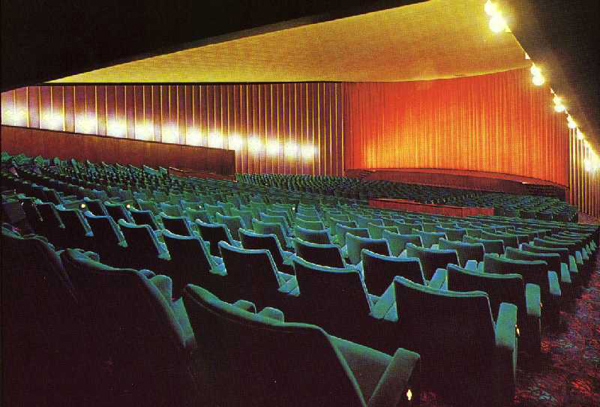 The
KinopalŠet by 1972. Picture: Rialto Cinema Group The
KinopalŠet by 1972. Picture: Rialto Cinema Group
Cinerama is still recalled in Denmark, but for most it is a hazy memory at best. A typical remark during a discussion about 70mm and big screens would be
"I remember the cinema with 3 pictures and dividing lines!".
During November 2001, the final evidence of 3-strip Cinerama projection in Denmark was removed, as
"KinopalŠet" became the target of the entrepreneurs wrecking ball. The
KinopalŠet, one of my favorite cinemas, closed as a cinema 20 years earlier and has since been used as office space. Quite often, I have looked at the building and
"time-traveled" back to my early days of movie going.
The name changed between "Kino-PalŠet", "ASA Bio" and "KinopalŠet/ASA Bio", but to me it has always been just
"KinopalŠet".
Ľ Go to
70mm, Cinerama and
Cinemiracle shown in Denmark
Ľ Go to
70mm Cinemas in
Denmark and the first 70mm film
In the early 1990s I met Mr. Ole S. Olsen, a former projectionist at KinopalŠet. Ole happily shared his memories about the days of Cinerama at
KinopalŠet. Thanks to him, you can now read a few details about Cinerama and what took place 40 years ago.
The history of KinopalŠet dates back to October 27, 1918 when the first cinema by that name opened. It was blown up during WWII March 31, 1944 and it would not be until April 16, 1950 that it would reopen. In the 50s KinopalŠet was among the technical elite of cinemas with Wide Screen, CinemaScope 4-track magnetic sound and 3-dimensional projection systems. This article is about the next (third) KinopalŠet incarnation with the most spectacular of all projection systems; Cinerama.
There was a need to replace the temporary building from 1950 with a completely new and state of the art cinema. The decision to build was taken in 1957 and it was scheduled to open in 1959.
|
Further in 70mm reading:
70mm Cinemas and Film in Denmark
Three Great Danish 70mm Cinemas
Ľ
Go to
The
3 Falke Bio
| Imperial Bio |
Imperial Bio - Design for Copenhagen
|
|
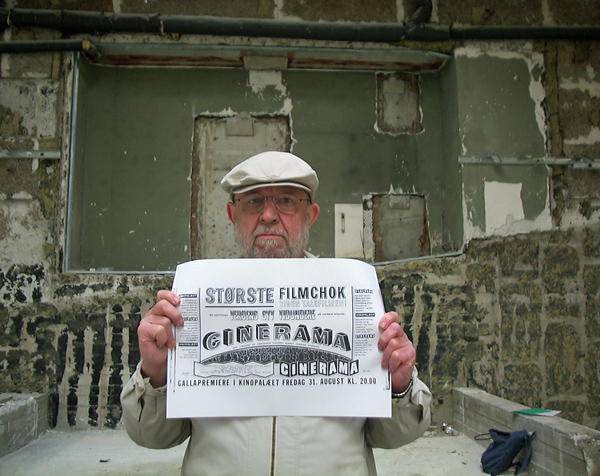 Ole
S Olsen, projectionist during Cinerama. Seen here in front of Able
projection room, shortly before KinopalŠet was demolished in 2001. Picture:
Thomas Hauerslev Ole
S Olsen, projectionist during Cinerama. Seen here in front of Able
projection room, shortly before KinopalŠet was demolished in 2001. Picture:
Thomas Hauerslev
The ambition was to not only equal previous cinemas but indeed to make it the most technically advanced cinema in Scandinavia. The architect selected for the job was Mr. Ole Hagen, who at the same time was completing
3 Falke Bio, the first Todd-AO cinema in Scandinavia.
KinopalŠet would be the 5th largest cinema in Copenhagen with 1225 seats. Only Palads Teatret (1519), Palladium (1410), Saga (2070) and World Cinema (1608) would have more seats at that time.
KinopalŠet opened Saturday 26, 1959 with the Danish comedy "Far til Fire pň
Bornholm". The first films to be shown in 70mm were "Solomon and Sheba" (01.02.1960) and
"Spartacus" (21.01.1962) in Super Technirama 70.
The main entrance was located at Gammel Konge Vej. After buying the ticket the patrons would walk upstairs and enter the huge 10 x 40 meters foyer.
There was a bar, restrooms and another two stairways leading to the auditorium. There were 1223 oak seats made by Odense Stole og
M°belfabrik. The 23 x 9 meter screen (Size as quoted in the press) was among the largest ever seen in Scandinavia at that time. The exits opened out to Vodrofsvej and Gammel
Kongevej.
Bauer's U2 universal projectors for 35mm and Todd-AO were selected for 70mm projection. Max 170 A with a 457mm cold light mirror. ISCO 87,5mm
T-Kiptagon with minifier. Amplifiers and speakers were Westrex type for 6-track Todd-AO, 4-track CinemaScope and mono optical sound. It was also possible to project 16mm film.
KinopalŠet became a very popular cinema thanks to its large screen, excellent sight lines and comfortable chairs. The press spoke highly favorably about the new cinema and Aktuelt
(December 27, 1959) proclaims "It's the best cinema in Copenhagen". In the years to come, however, KinopalŠet would be
re-membered for something else and much more spectacular. A cinematic novelty known as CINERAMA.
|
|
Dansk Kinematograf Fabrik A/S measured the screen size November 17, 1959. The screen was 8 meters high and projection distance was 36,2 meters.
|
|
Format x:1
|
Width
|
f: in mm
|
|
|
|
|
1,37 (35mm)
|
11 m
|
68,78
|
|
1,66 (35mm)
|
13 m
|
58,2 |
|
2,21 (70mm)
|
17,6 m
|
98,15
|
|
2,35 (35mm)
|
18,4 m
|
82,23
|
| 2,55 (35mm)
|
20,4 m
|
82,23
|
|
|
|
|
|
Enter Cinerama
|
|
|
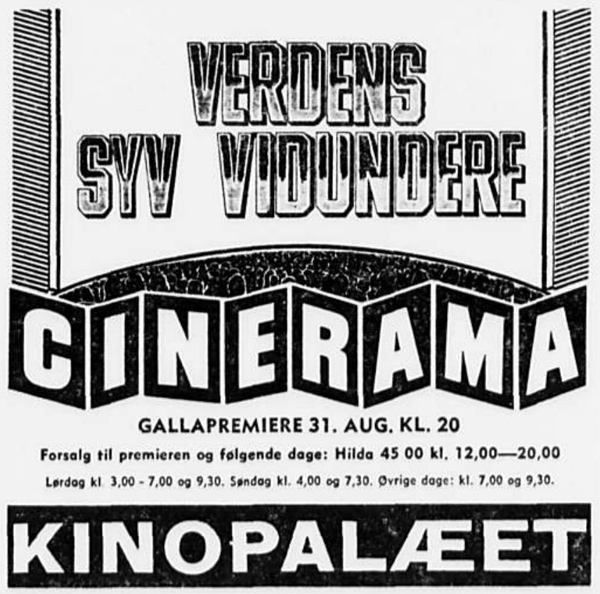 In 1961 the manager Mr. Lau Lauritzen Jr. succeeded in negotiating a 5-year contract with Cinerama. Inc. in Paris. He was confident that Cinerama was going to be a major winner. In 1961 the manager Mr. Lau Lauritzen Jr. succeeded in negotiating a 5-year contract with Cinerama. Inc. in Paris. He was confident that Cinerama was going to be a major winner.
And so, KinopalŠet closed June 18, 1962 to install 3-strip Cinerama. It took two months to refit the cinema with a new deeply curved louvered screen (and losing around 100 seats), a pair of new projection rooms, a set of 3 Cinerama projectors and a sound
follower/dubber. The cost was enormous and amounted to DKK 700.000.
The side projection rooms were hung in the ceiling, which meant the projectionists should be quite careful because any movement could easily be seen on the screen.
A team from Cinerama Inc. directed by chief technician Mr. Ernest Muncer (Britain) installed the equipment. They were very experienced and travelled from place to place setting up Cinerama cinemas. Mr. Muncer was described as funny, very skilled and a perfectionist. There were conflicts between the existing projection team, in particular chief projectionist Mr.
M°ller, and the Cinerama team on how to do things. The Cinerama Inc. policy had been to fire the old staff and hire new to run Cinerama but eventually peace was restored and it was not to be the case in Copenhagen.
The projectors were Centurys, and they most likely came from the Cinemiracle installation that closed in spring 1960 in Copenhagen. It has been impossible to verify that. The lamp houses were huge and run at 160 amps with water-cooled carbons. The 8-track dubber was new. Loops from "How the West Was Won" were used to test the projection quality as well as special instruments to measure distances in the auditoria.
The three projection rooms were known (like everywhere else) as Able, Baker and Charlie. Baker was the main projection room. Able was the right projection room (projecting the left screen panel) and finally Charlie, the left projection room. To make room for the Baker machine, the left Bauer U2 was removed. The right U2 was used only for commercials and breakdown films. Projection distance from Baker was 37 meters. From Able and Charlie, 21 meters.
|
|
The Big Screen
|
|
|
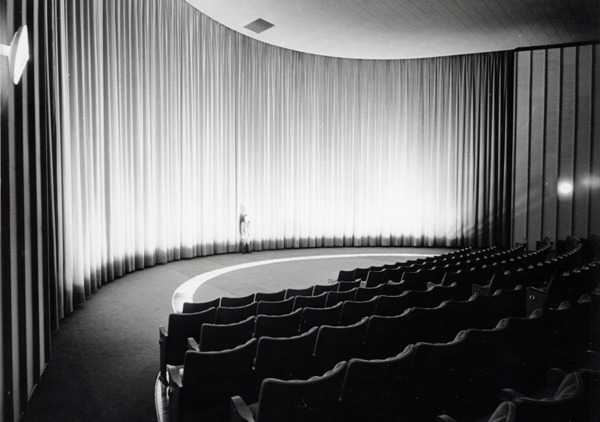 Cinerama
curve. Picture: Danish Film Museum archive Cinerama
curve. Picture: Danish Film Museum archive
The louvered 146║ screen was installed around August 15, 1962. Screen size was 27,2 m x 9,7 m. Screen chord was 21 meters. The depth was 7,4 meters. Format along the curve was approximately 2,79:1, and when viewed from the back of the theatre around 2:1. It was a huge screen covering the entire end wall of the auditorium. The screen was made of 2150 louvers, each 2 cm wide, fixed at the top, bottom and middle of the screen frame. In order to secure the maximum light being reflected towards the audience (and not the deeply curved screen), every louver was fixed at a specific angle from the projector. The louvers were checked regularly.
Mr. Muncher calculated the "sweet spot" *) to be the 7th row from the screen. From that row the audience would get the most dynamic impact of Cinerama.
The first Cinerama film "Seven Wonders of the World" opened Friday August 31, 1962 to a specially invited audience for the benefit of United Nations children's foundation UNICEF under the protection of US ambassador Mr. William
McBlair, Jr.
Ticket prices during Cinerama were (in Danish kroner) 4, 6, 10, 11 and 15. Show times were 19:00 and 21:30 (Monday - Friday), 15:00, 19:00 and 21:30 on Saturdays and 16:00 and 19:30 on Sundays.
For every show 4 projectionists were required: one man for each projector and a fourth to rewind and maintain the large (Model 34) reels. The chief projectionist was in charge of Baker. Next to Able and Charlie sat a framer who's sole responsibility it was to maintain the horizon on the screen image. The rewind man checked Able and Charlie before each show.
After the commercials that were shown on the Bauer U2, the "Cinerama Red" curtain was closed. All three machines and the 35mm dubber were electrically locked together. When the chief pushed the button next to the Baker machine, Able and Charlie and the sound dubber would all start at the same time.
An introductory film about the complexity of Cinerama was shown only before "Seven Wonders of the
World".
|
*)
Seats where the screen image appears as it would in real life (A first person experience = peripheral vision). |
|
Only 5 films were shown in 3-strip Cinerama:
| "Seven Wonders of the World" |
31.08.1062
and 26.07.1963 |
| "How the West Was Won" (MGM) |
26.12.1962 |
|
"Cineramas South Seas Adventure" |
04.06.1963 |
| "The Wonderful World of the Brothers Grimm" (MGM) |
21.08.1963 |
| "Cinerama Holiday" |
27.09.1963 |
The 2 MGM titles were subtitled in Danish, however, the letters were very small on the big screen, and some even complained about that.
|
|
A Complicated Process
|
|
|
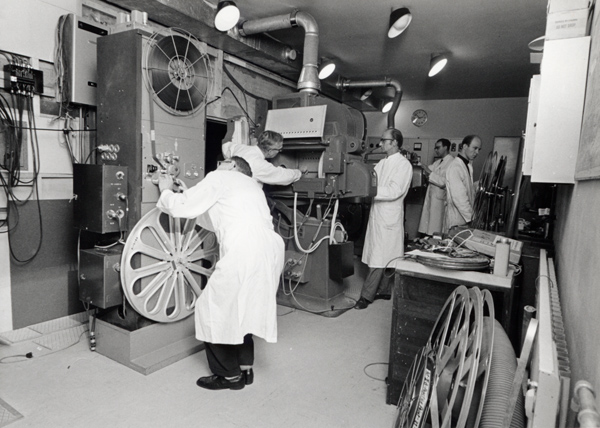 Cinerama
projection room Baker. Piture: Danish Film Museum archive Cinerama
projection room Baker. Piture: Danish Film Museum archive
Cinerama was a complicated process to show, compared to regular 35mm film. Imagine 3 strips of film and a strip of 35mm sound had to fit precisely onto 4 reels of film. Even 3-strip Cinerama trailers were worked into the program.
Whenever a film broke, the broken part of the film had to be repaired. If a frame or more had to be cut, the same amount of film had to be cut on all 4 reels! Alternatively, the broken frames could be replaced by a piece of black film limiting the repairs to only one reel.
If a longer replacement of film was needed, Technicolor in London reprinted the necessary piece of film overnight. All Technicolor had to know was the foot numbers and the YCM filtration, which was printed on the edge of the film. The filtration, however, only rarely matched.
All Cinerama films were identified with foot numbers, along the edge of the filmstrip. A sort of an identification number making it easy for the laboratory and projectionist to find his way around the reel.
During a breakdown of Cinerama, special "breakdown" films were shown to the audience.
|
|
Cinerama the Fiasco
|
|
|
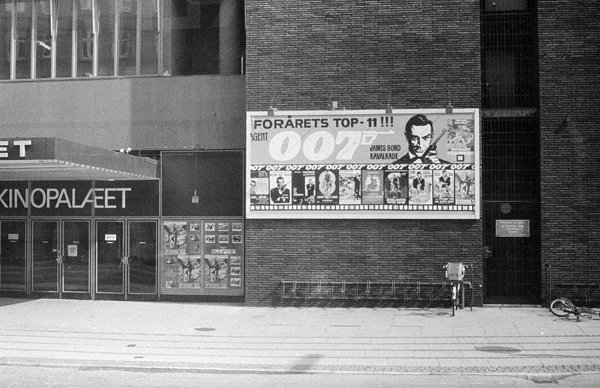 KinopalŠet
24-sheet poster on facade. Picture: Thomas Hauerslev KinopalŠet
24-sheet poster on facade. Picture: Thomas Hauerslev
3-strip Cinerama was not successful in Denmark. Mr. Lauritzen explained the reasons for the failure to the Berlingske Tidende October 22, 1963: "The audience are used to other wide screen systems, we came too late with Cinerama
2), and it has it's flaws with the join lines! We will continue with Cinerama but with a more simple approach. A new technique with 70mm allow us to use the entire Cinerama screen with one strip of film -
70mm". 3)
In October 1963, only 14 months after the spectacular opening, the 3-strip equipment was taken out, stored and eventually donated to the Danish Film Museum around 1972. The Film Museum, however, had no clue of what to do with this equipment, and according to evil tongues threw everything away in February 1984. Charlie projection room became a storage room for tickets.
Opening reception with the architect Ole Hagen (right) and the manager lau
Lauritzen, jr. (left).
In 70mm Cinerama
October 28, 1963 KinopalŠet premiered "The Ugly American" starring Marlon
Brando. 6 weeks later on December 10, 1963, KinopalŠet was closed again to install DP70 projectors. One U2 remained in the projection room for commercials.
KinopalŠet is reopened 11 days later on December 21 to celebrate the Scandinavian opening of Stanley Kramer's
"It's a Mad, Mad, Mad, Mad World" in Ultra Panavision 70. On that occasion Stanley Kramer visited Copenhagen.
For those who still remember the deeply curved 70mm wall-to-wall ceiling-to-floor screen, the image was absolutely stunning.
|
|
|
2) It
took Cinerama 10 years to reach Denmark after the 1952 world premiere in
New York. By that time the buzz was over.
3) Attendance was generally lower in all Copenhagen cinemas the first 10 months of 1963, according to newspapers.
The Cinerama deep-curve screen was used until 1972 for a diverse range of 70mm premieres:
|
"The Fall of the Roman Empire" |
07.10.1964
|
|
"Circus World"
|
26.11.1964
|
|
"Cheyenne Autumn"
|
24.04.1965
|
|
"The Greatest Story Ever Told"
|
29.10.1965
|
|
"The Hallelujah Trail"
|
28.02.1966
|
|
"Agony and Ecstasy"
|
09.05.1966
|
|
"The Great Race"
|
09.06.1966
|
|
"Shellerama" (short) |
09.06.1966
|
|
"Battle of the Bulge"
|
22.08.1966
|
|
"Khartoum"
|
24.10.1966
|
|
"Grand Prix"
|
03.04.1967
|
|
Custer of the West"
|
30.08.1968
|
|
"STAR!"
|
08.11.1968
|
|
"Oliver!"
|
20.01.1969
|
|
"Krakatoa"
|
31.10.1969
|
|
|
New Management
|
|
|
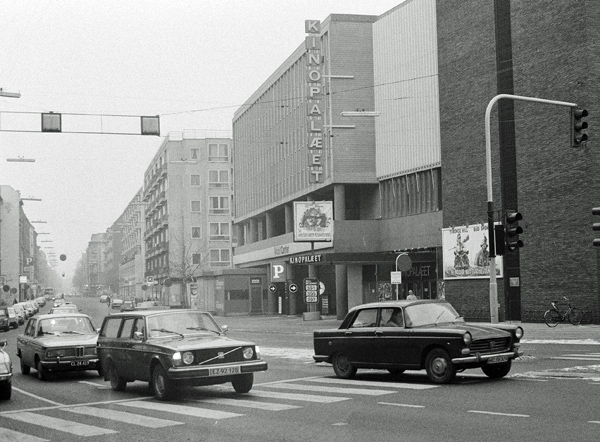 KinopalŠet
on Gammel Kongevej in December 1979. Picture Thomas Hauerslev KinopalŠet
on Gammel Kongevej in December 1979. Picture Thomas Hauerslev
Until
1972 Danish Film Production company ASA Film Studier owned the cinema. By
then it was becoming increasingly difficult to find suitable films. New
small "Art Cinemas" had been opened and audiences seemed to like this new
trend toward intimate cinemas. To meet this demand the idea of rebuilding
KinopalŠet into 3 screens was suggested in 1970. One 750 seater (KinopalŠet)
and two screens (ASA Bio #1 & ASA Bio #2) each housing 175 seats were
proposed. (Ironically the two small screens would be larger in terms of
seats, than the average cinema in Copenhagen today!).
The plan was abandoned and ASA Studios sold the cinema to Preben Philipsen
February 1, 1972. Preben Philipsen's father, Constantin Philipsen, opened
the first permanent Danish cinema in 1904 and the first KinopalŠet October
27, 1918. Philipsen completely renovated the cinema for 2 million kroner: a
new stage in front of the screen, new lights, new carpeting, new seats and a
new 16-meter slightly curved single sheet screen. The architects on the
rebuilding were Erik Engelstoft and Svend Nielsen.
After 8 weeks closure the "new" cinema is re-opened on October 16, 1972. US
ambassador Fred Russel attends the premiere of "What's Up Doc?". The
chairs designed by MDA Kurt ěstervig (1912 - 1986) received much acclaim.
Preben Philipsen later acquired other cinemas in- and outside Copenhagen and
the first chain of cinemas became a reality with the introduction of "The
Rialto Cinema Group".
The lamp houses on the DP70s were the original Ashcraft Super Cinex and the
carbons were always operated at 150 amps! It was not until 1976 that 6500
xenon and new Cinemeccanica lamp houses were installed. The view out of the
projection room at KinopalŠet was very spectacular as a very large window
revealed everything that was going on inside. It was a majestic sight to see
the DP70s punching light out towards the big screen. For a little boy, being
the projectionist at KinopalŠet surely was THE job to have.
Dolby Stereo (CP50) was introduced for the premiere of "Moonraker"
(13.08.1979). A few years earlier Sensurround had been installed for
"Rollercoaster" (20.01.1978).
|
4)
|
Change of Management
|
|
|
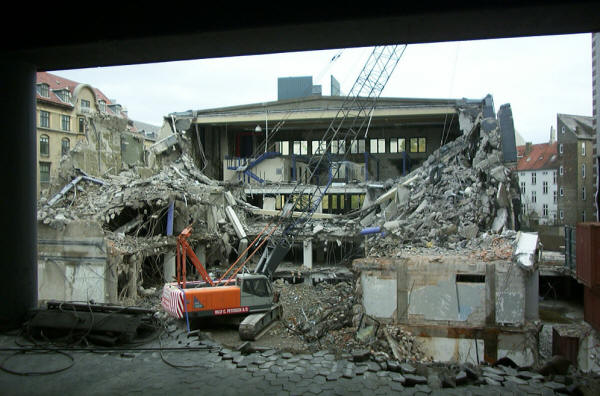 KinopalŠet
is demolished in November 2001. Picture: Thomas Hauerslev KinopalŠet
is demolished in November 2001. Picture: Thomas Hauerslev
The 1970s was not kind to KinopalŠet. Several cinema moguls: Preben Philipsen (1972), J°rgen Lademan (1974), Bent Fabricius-Bjerre (1978) and Henrik Sandberg (1978) all tried to make it profitable. The repertoire was a variety of action movies starring Charles Bronson and Clint Eastwood. A few summer season revivals billed as "The Cavalcade of Giants" was shown in 70mm and 35mm (A new film each day for a couple of weeks) but to no avail. James Bond cavalcades in the summer of 1978, 1979 and 1980 did prove very popular. But alas, that was too little too late.
The cinema was finally closed in 1981, no thanks to a deficit of half a million
kroner. The last film was "Cattle Annie and the Little Britches" (02.02.1981).
After the final performance on February 12, 1981 the light was switched off for the last time and the cinemas went dark. Or so they thought, because February 27, 1981, 15 days later, it was reopened to run the Danish film
"Circus Casablanca" for two weeks after which KinopalŠet finally is closed.
By an odd coincidence, projectionist Jan Niebuhr (Still projecting films) is on duty on both evenings. So he gets the questionable pleasure of closing the most spectacular Danish cinema ever, twice!
After closure March 15, 1981 all seats were sold, except the most worn which ended up in Studio Bio (porno house) a few blocks away. The projectors were exported to Bio Trio (Suburb to Copenhagen). The rectifiers were moved 700m meters up the road to Imperial Bio (where they still are) and finally the Dolby CP50 and the Philips amplifiers migrated to Cinema 1-8 screen #1 on
Vesterbrogade.
The owner of the building insurance company CODAN, tried without success to find a new tenant. Several ideas were discussed: a concert hall and a radio studio among them, however, they finally gutted the interior and reused the cinema for their computer and office needs. The main entrance became CODANS walk-in customer insurance service center in September 1983 (And later a bank). The large foyer upstairs became a canteen, the sloped floor was removed and large windows were installed in the walls. The rebuilding was very complicated and cost around 20 million
kroner, nearly 10 times as much as it cost to build the cinema 25 years earlier!
Outside, only very few traces lets the casual spectator know about the super cinema status this building once had. You can still see Able and Charlie projection rooms. The canopy survived until 2001 and until 1993 it was still possible to see where the 24-sheet poster sat. The building was demolished
between October 29 and November 16, 2001 to make room for a new 6-floor office block.
|
|
|
|
|
Go: back
- top - back issues
Updated
22-01-25 |
|
|

 The
KinopalŠet by 1972. Picture: Rialto Cinema Group
The
KinopalŠet by 1972. Picture: Rialto Cinema Group Ole
S Olsen, projectionist during Cinerama. Seen here in front of Able
projection room, shortly before KinopalŠet was demolished in 2001. Picture:
Thomas Hauerslev
Ole
S Olsen, projectionist during Cinerama. Seen here in front of Able
projection room, shortly before KinopalŠet was demolished in 2001. Picture:
Thomas Hauerslev In 1961 the manager Mr. Lau Lauritzen Jr. succeeded in negotiating a 5-year contract with Cinerama. Inc. in Paris. He was confident that Cinerama was going to be a major winner.
In 1961 the manager Mr. Lau Lauritzen Jr. succeeded in negotiating a 5-year contract with Cinerama. Inc. in Paris. He was confident that Cinerama was going to be a major winner. Cinerama
curve. Picture: Danish Film Museum archive
Cinerama
curve. Picture: Danish Film Museum archive Cinerama
projection room Baker. Piture: Danish Film Museum archive
Cinerama
projection room Baker. Piture: Danish Film Museum archive KinopalŠet
24-sheet poster on facade. Picture: Thomas Hauerslev
KinopalŠet
24-sheet poster on facade. Picture: Thomas Hauerslev KinopalŠet
on Gammel Kongevej in December 1979. Picture Thomas Hauerslev
KinopalŠet
on Gammel Kongevej in December 1979. Picture Thomas Hauerslev